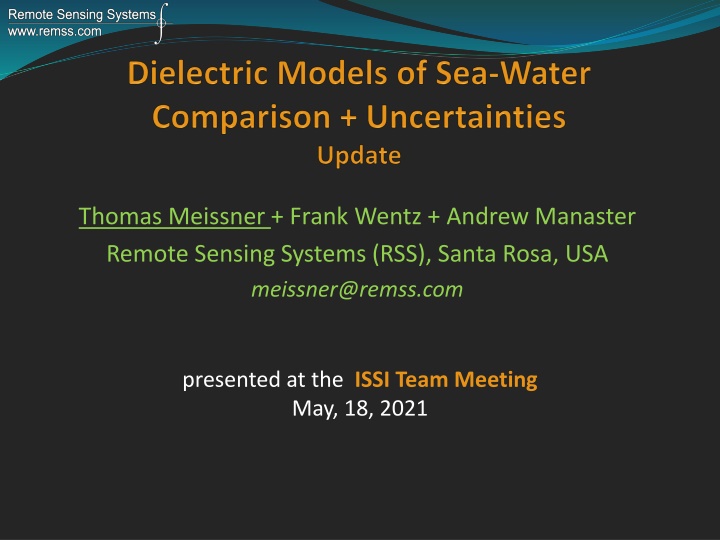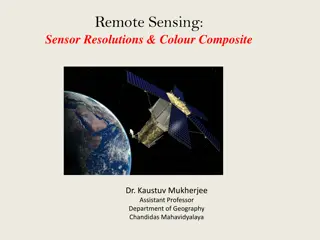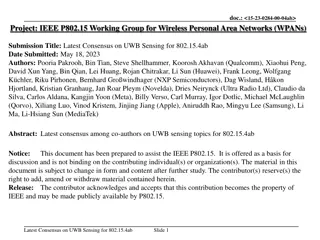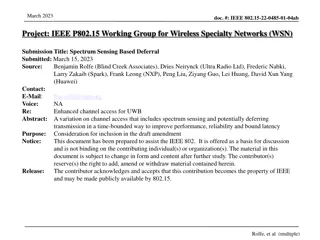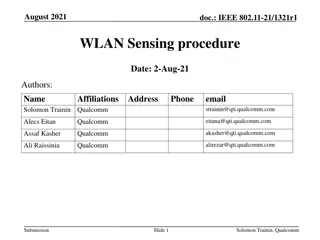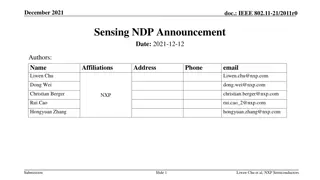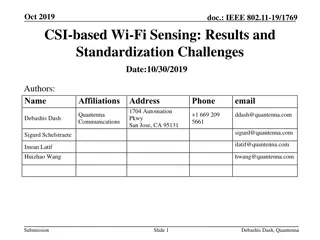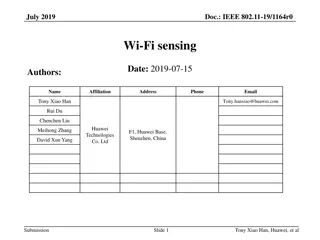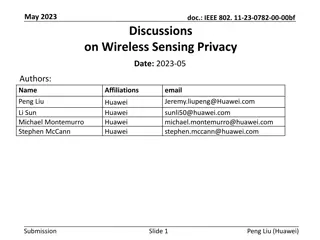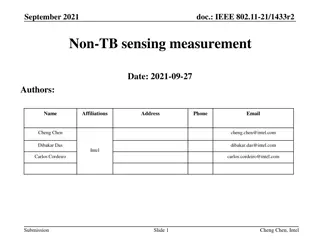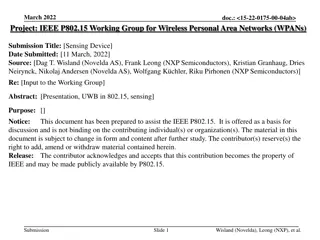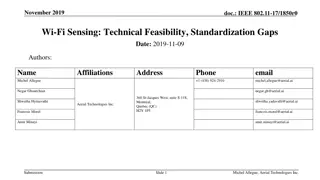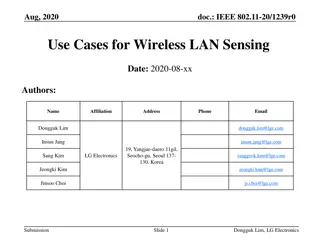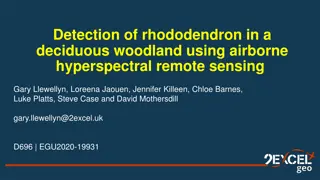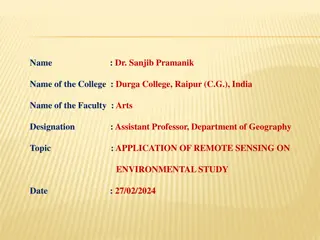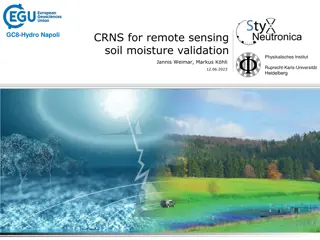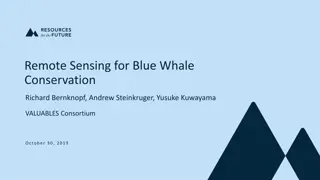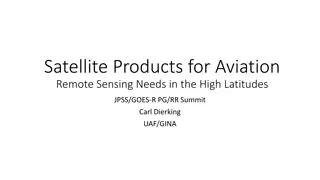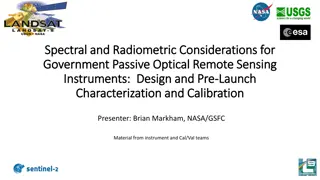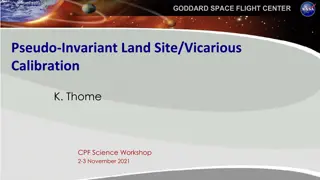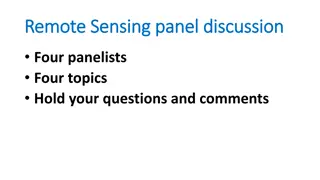Remote Sensing Systems Overview
Thomas Meissner, Frank Wentz, and Andrew Manaster from Remote Sensing Systems presented at the ISSI Team Meeting on May 18, 2021. The presentation includes comparisons with GWU 2020 data, analysis of surface TB, updates on ST expressions, and radiometric differences in surface TB measurements. Detailed insights into the remote sensing technology and its applications are discussed in the presentation.
Download Presentation

Please find below an Image/Link to download the presentation.
The content on the website is provided AS IS for your information and personal use only. It may not be sold, licensed, or shared on other websites without obtaining consent from the author.If you encounter any issues during the download, it is possible that the publisher has removed the file from their server.
You are allowed to download the files provided on this website for personal or commercial use, subject to the condition that they are used lawfully. All files are the property of their respective owners.
The content on the website is provided AS IS for your information and personal use only. It may not be sold, licensed, or shared on other websites without obtaining consent from the author.
E N D
Presentation Transcript
Thomas Meissner + Frank Wentz + Andrew Manaster Remote Sensing Systems (RSS), Santa Rosa, USA meissner@remss.com presented at the ISSI Team Meeting May, 18, 2021
Comparison with GWU 2020 FREQ=1.41GHz, EIA=40 , V-pol MW2012 FASTEM5 SST from 0 C to 30 C in steps of 1 C. SSS from 30 psu to 38 psu in steps of 1 psu. TB surface = Emissivity SST (Kelvin). Similar to MW But larger SSS dispersion BV2020 KS
Surface TB versus Meissner-Wentz 2012 EIA=55 V-pol SSS=35psu Debiased L-band C-band FASTEM5 stays very close to MW. All other models ramp up significant SST gradient. Unlikely to be usable in AMSR2 retrievals (SST, Wind).
Surface TB versus Meissner-Wentz 2012 EIA=55 V-pol SSS=35psu Debiased X-band K-band FASTEM5 stays very close to MW. All other models ramp up significant SST gradient. Unlikely to be usable in AMSR2 retrievals (SST, Wind).
Surface TB versus Meissner-Wentz 2012 EIA=55 V-pol SSS=35psu Debiased Ka-band W-band W-band dominated by , 1 and 2
Update: ST MW (1) ST expression for imaginary part reduces to conductivity term for low frequencies ( 0) : ( ) , T S ( , ) c T S ( ) eff i , T S 0 + 2 1 i 0 eff is about 1 THz.
Update: ST MW (2) L-band Ka-band Blue curve : ST with conductivity term. Uses Stogryn expression for pure water. Orange curve : ST with conductivity term. Uses MW expression for pure water. Green curve: ST model without low-frequency approximation. Uses Stogryn expression for pure water = effectively same as blue curve.
Radiometric Differences Surface TB EIA=55 V-pol SSS=35psu 0 C<SST<30 C Of interest in the variability with SST and SSS over dynamic range encountered over ocean (last column). Overall bias Can be removed in sensor calibration. Could be bias in experimental set-up. Frequency [GHz] Comparison Bias (Kelvin) Std.Dev (Kelvin) 1.41 GWU2020 - MW2012 -0.24 0.09 6.9 0.18 0.18 10.7 0.07 0.16 18.7 -0.16 0.14 FASTEM5 - MW2012 37.0 -0.33 0.39 85.5 Guillou1998 - MW2012 -0.56 0.36 using laboratory measurements
Permittivity Differences SSS=35psu 0 C<SST<30 C Measurements/Models MW2012 fit Measurement Model Frequency [GHz] Re( ) Bias Re( ) Std.Dev Re( ) Rel. Prec. Im( ) Bias Im( ) Std.Dev. Im( ) Rel. Prec. 1.41 GWU2020 MW 0.51 0.30 0.4% 0.28 0.28 0.4% 6.9 -0.29 0.96 1.6% 0.73 0.30 0.8% 10.7 -0.66 1.09 2.2% 0.52 0.18 0.4% FASTEM5 - MW 18.7 -0.82 0.86 2.7% 0.06 0.50 1.4% 37.0 -0.64 0.41 2.7% -0.36 0.57 2.2% 85.5 Guillou1998 MW 1.78 0.11 1.3% 0.30 0.14 1.1%
Summary and Remaining Issues (1) L-band: MW 2012, ST, BV 2020, GWU 2020 are within +/-0.1 K. As good as one can hope for remote sensing applications. Too many other large spurious signals that correlate with temperature: wind roughness, atmosphere, galaxy, Good agreement between MW and FASTEM for C-band and higher. Little exception: I would not recommend FASTEM at L-band (spurious salinity dependence). I would not endorse any of the other models (KS, GWU, ST, BV) above L-band in their current form. Likely need to retrieval biases in SST, (wind, cloud, vapor, ) Would require tuning of parameters. It is not clear if and how much that could be done.
Summary and Remaining Issues (2) Error (uncertainty) bars to be integrated into FORTRAN code. Interpolation from tabulated values.
GWU 2020 1.4 GHz laboratory measurements. Single-Debye fit. Shortcomings of earlier versions (unrealistic salinity dependence) have been corrected. Can be considered for remote sensing applications Salinity retrievals with L-band sensors (SMOS, Aquarius, SMAP). Will likely require small adjustments in GMF, e.g. the SST dependence of the wind emissivity. Comparison with MW: within +/-0.1 K over dynamical ocean range. The GWU fit can only be used at L-band. General Remark: It took 10+ years to complete all measurements and fits. That reflects the challenge to measure the dielectric constant of sea-water in the laboratory. Beware regarding published laboratory data as truth. Screening with ocean remote sensing data is important and necessary. 1.
Somaraju - Trumpf Good physical model for S(TS,SSS). Valid at low frequencies (L-band). Unlikely usable at higher frequencies without further adjustments. SST biases. Same applies to Boutin Vergely. General small ambiguity in L-band spaceborne salinity retrievals (SMOS, Aquarius, SMAP): Temperature dependence in dielectric constant model. Small temperature dependence in wind emissivity. Hard to distinguish. 2.
FASTEM5 General good agreement with Meissner-Wentz over very wide frequency range (L W bands). Both dielectric models are based on similar input. Expected to have similar performance when used in Satellite retrievals. Assimilation. Holds at S = 35 psu (global ocean average). Little exception: Unrealistic looking salinity dispersion seems rather large. Already visible at L-band compared to GWU, MW, SOM. Might be a problem for L-band salinity retrievals in fresh-water areas (sea-ice melt off, river plumes) Dispersion increases at higher frequencies. 3.
